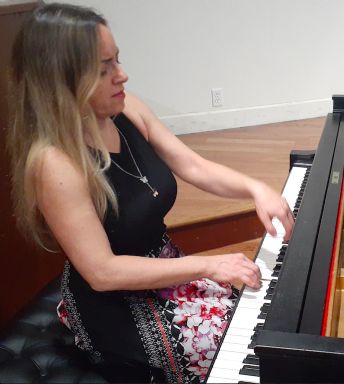|
Symphony
FROM THE NEW WORLD TO THE OLD WORLD
by Peter Lert
Saturday, June 14, 2025
Chamber
MC2 DUO RECITAL CLOSES 222'S SEASON
by Terry McNeill
Saturday, June 14, 2025
Choral and Vocal
CANTIAMO SONOMA'S LUSCIOUS A CAPELLA SINGING IN SEASON ENDING CONCERT
by Pamela Hicks Gailey
Sunday, June 8, 2025
Symphony
SRS SEASON ENDS WITH RESOUNDING TA-TA-TA-BANG
by Terry McNeill
Sunday, June 1, 2025
Symphony
YOUTHFUL VIRTUOSITY ON DISPLAY AT USO'S MAY CONCERTS
by Peter Lert
Saturday, May 17, 2025
Symphony
MYSTICAL PLANETS AND LIVELY GERSHWIN ORTIZ AT FINAL SRS CONCERT
by Peter Lert
Sunday, May 4, 2025
Symphony
VSO'S CONCERT MUSIC OF TIME, MUSIC OF PLACE
by Peter Lert
Sunday, April 27, 2025
VOCAL ELEGANCE AND FIRE AT THE 222'S RECITAL APRIL 26
by Pamela Hicks Gailey
Saturday, April 26, 2025
CANTIAMO SONOMA SINGS AN INSPIRED GOOD FRIDAY MOZART REQUIEM CONCERT
by Pamela Hicks Gailey
Friday, April 18, 2025
DRAMATIC SHOSTAKOVICH SYMPHONY CLOSES PHILHARMONIC'S 25TH SEASON
by Terry McNeill
Sunday, April 13, 2025
|
 |
 Laura Magnani at ECHO Concert (A. Wasserman Photo) |
PREMIER OF KAIZEN AND DRAMATIC MOZART HIGHLIGHT ECHO CHAMBER CONCERT
by Abby Wasserman
Sunday, February 16, 2020
As concertgoers took their seats in San Anselmo’s First Presbyterian Church for ECHO Chamber Orchestra’s February 16 program, they were surprised to see at center stage two bass drums, a tom-tom, bongos, high hat and cymbals.
It was the occasion of the world premiere of "Kaizen," composed and performed by ECHO percussionists Christian Foster Howes and Alapaki Yee. Mr. Yee explained from the stage that "Kaizen" is a Japanese term “about the small, consistent changes we go through in our lives.” From its opening strikes and rolls, the piece immersed the audience in insistent pulse, pitch changes, shifting tempos, and surprising tonalities. It was a reminder of how musical drumming can be. The musicians formed intricate patterns with buttery taps, sharp strikes, thunder-like rolls and rumbles, and tuneful variations in pitch. It was mesmerizing. At the conclusion there was a split second of silence, then the audience showered the composers with applause and the kind of whistles one hears at a sports game.
The next surprise was to see the piano positioned on the platform at the rear of the stage for Laura Magnani’s performance of Mozart’s D Minor Concerto, No. 20, K. 466. Mozart wrote some of his most heartrending music in D minor, including the Requiem and parts of the opera Don Giovanni. Before taking her seat at the piano, Ms. Magnani described the avant-garde character of the concerto and said that Beethoven, who greatly admired this work, wrote the cadenzas she would perform.
The first Allegro movement began with an ominous orchestral introduction with cries of suffering from the violins. When the piano part entered, its tones rising bell-like above the orchestra, the mood softened, and a seesaw of darkness and light continued throughout the movement. The tension never fully lifted: even in the lovely Romanze second movement, sudden storms arose. The tumultuous third movement, Rondo: Allegro assai, built to a climax, the orchestra providing momentum and pulse, the piano its translucent partner. After thrilling pianistic runs and intricate trills, Ms. Magnani ended the concerto at a gallop. Her playing was lithe and muscular, faithful to the score and spirit, and deeply expressive. The solo cadenzas made a palpable connection between Mozart and Beethoven.
A sustained standing ovation elicited an encore: Chopin’s Fantaisie Impromptu, Op. 66, which Ms. Magnani performed dazzlingly.
In the interval before the final work, Louise Farrenc’s G Minor Symphony No. 3, Opus 36, flutist and Orchestra Manager Carol Adee noted how little about Farrenc appeared in even recent music dictionaries, and how important ECHO considers her music. Last year Mr. Canosa conducted her delightful Nonet. Farrenc (1804-1875) was a virtuoso pianist and prolific composer as well as a faculty member at the Paris Conservatory for 30 years. The first movement, Adagio-Allegro, began with a single eloquent voice from oboist Margot Golding, leading into a pastoral section rich with harmonies of woodwinds and French horns. The symphony calls for a full orchestra, but size was rarely an issue in this ensemble, except during certain beautiful passages where the three cellos could have benefited from additional players for volume.
The horns introduced the Adagio Cantabile, out of which Kyle Beard's clarinet sang an exquisite theme. The unison strings built intensity while overall, the movement remained pastoral. Movement three was played as agitated and alive, with close harmonies of horn, flute, clarinet, oboe and bassoon, while the strings played pizzicato. The concluding Finale-Allegro was thrilling, with the conductor shaping the music to a lyrical mood before its close.
A reception allowed attendees to enjoy refreshments, see local art and mingle with the musicians.
|

